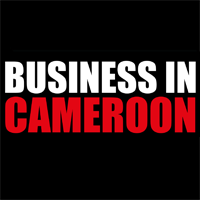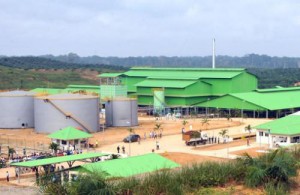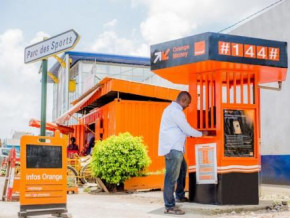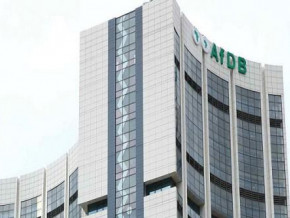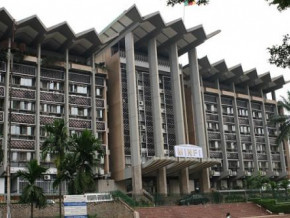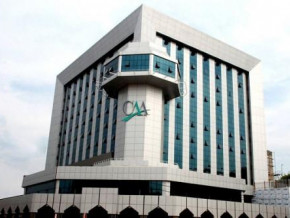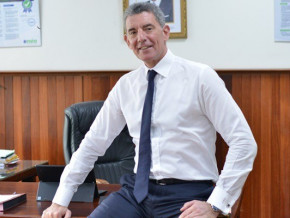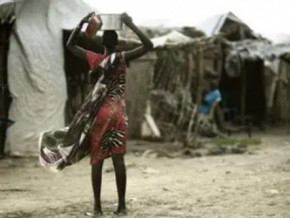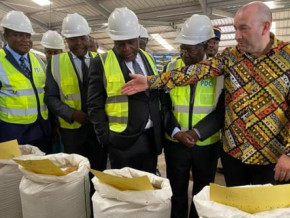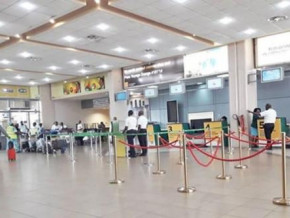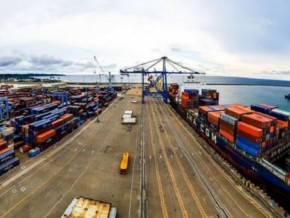
Cameroon is now imports palm oil from Gabon
The Gabonese palm oil refinery Awala made, on 27 October 2016, its first exports of palm oil and palm kernel oil to Cameroon and Spain, the Gabonese press announced.
The packaging of the cargo of approximately 300 tons of palm oil and 180 tons of palm kernel oil, we learned, was done in the presence of the Minister of Agriculture and Livestock in charge of the “Graine” programme, Yves Fernand Mamfoumbi.
These first Gabonese exports of palm oil are the results of a programme to diversify the economy of this country launched a few years ago by President Ali Bongo, in order to make Gabon less dependent on oil production.
The Awala thus finds in Cameroon an excellent market, since this country presented as the economic engine of the CEMAC zone has been facing, for years, a deficit in terms of palm oil production, a deficit which is officially estimated at about 100,000 tons per year.
This year, for example, the Cameroonian government had to, once again, grants authorisations for preferential imports of close to 60,000 tons to oil refiners, in order to make available the raw material for the production of vegetable oils, soap, etc.
BRM
Over 41% increase in outstanding receivables for banks in the CEMAC zone, according to Cobac
During the last meeting organised a few days ago in Cameroon by the Central African Banking Commission (COBAC), with the managers of commercial banks operating in the six countries in the CEMAC zone (Cameroon, Congo, Gabon, CAR, Chad and Equatorial Guinea), it came out that outstanding receivables saw an increase of 41.6% as at end July 2016, “thus degrading the apparent quality of the credit portfolio”.
According to the analysis made by COBAC, the watchdog in the banking sector within the Central African States Community (CEMAC), this increase in the outstanding loans is due to “the significant increase in long term receivables and doubtful accounts”.
In absolute value, these outstanding receivables had already reached the sum of FCfa 894 billion as at end March 2015, thus approximately 11.8% of the gross loans granted over this period by all the banking institutions (about 50) in this community.
BRM
Cameroon and Gabon looking for FCfa 17 billion in the BEAC securities market on 2 November 2016
The market of public securities of the Bank of Central African States (BEAC - Banque des Etats de l’Afrique centrale), issuing institution of the six member states of CEMAC which are Cameroon, Congo, Gabon, Central African Republic, Chad and Equatorial Guinea, will be very busy this 2 November 2016.
And for a reason, Cameroon and Gabon, the principal actors in this market since its creation in 2011, aim to raise with investors, an overall envelope of FCfa 17 billion, of which FCfa 10 billion for the Gabonese Treasury ; by means of two issues of Treasury bills (BTA) with a 13-week maturity.
In order to reap this pot of money, Cameroon is throwing its 16 Primary dealers (SVT - spécialistes en valeurs du Trésor) into this battle to mobilise funds, out of which four are shared with Gabon (Afriland, Ecobank, UBA and UBC). This CEMAC country is lining up 13 SVT for this operation.
As a reminder, since last year, the BEAC securities market is solicited more and more by the States, due to the fall in crude oil prices. This global economy has created a drastic decrease in public revenues in a number of CEMAC countries, like Gabon, Congo, Chad and Equatorial Guinea.
BRM
Lire aussi
27-10-2016 - La Beac abaisse le taux de la croissance de 1,8 à 1,7% pour l’année 2016
Common bank card is officially launched in six member States of CEMAC
The Inter Bank Money Group of Central Africa (GIMAC - Groupement interbancaire monétique de l’Afrique centrale) proceeded on 21 October 2016 in Douala, the economic capital of Cameroon, with the official launch of the interbank GIMAC card. This instrument now allows operations at terminals and other ATMs of banks in activity in the six States of CEMAC which are Cameroon, Congo, Gabon, Central African Republic, Chad and Equatorial Guinea.
This official launch, we learn, intervenes well after the start of use of this card, which has been operational since the first quarter of 2015. According to the management of GIMAC, this communal bank card, actually used on the networks of 20 banks in the CEMAC zone, has already resulted in transactions of around FCfa 5 billion to date.
This volume of transactions should increase tenfold with the official launch of the card. For example, after the Douala ceremony, the International Bank of Cameroon of Savings and Credit (BICEC - Banque internationale du Cameroun pour l’épargne et le crédit), subsidiary of the French Group BPCE, immediately announced to its clients having 100 ATMs open on the GIMAC network. In fact, if it is involved in the financial integration of the countries of the CEMAC zone, the GIMAC card arrives in a market where Visa and Mastercard already reign supreme. From this point of view, the main challenge for GIMAC lies in its capacity to identify the right formula, so that its communal bank card finds its way in an environment where it is an infant called to compete with adults.
BRM
Bank deposits recede by close to 2% in CEMAC area, due to financial difficulties of States
FCfa 9827 billion. This is the volume of deposits made into the banks in the CEMAC area as at July 2016 ending. According to the Bank of Central African States (BEAC), which has just disclosed this statistic during a meeting with bankers of this community in Douala, these deposits are however close to a 2% decrease compared to the same period in 2015.
The cause of this contraction in bank deposits, the BEAC underlines, is due to the decrease of deposits made by the six CEMAC member states (Cameroon, Congo, Gabon, Central African Republic,Chad, Equatorial Guinea), as well as by companies in their portfolio.
This situation itself results from a decline in public revenues, hampered by the unfavorable international economic conditions of raw material prices. It mainly concerns crude oil, which makes up between 50 and 80% of public revenues in four of the CEMAC countries (Gabon, Chad, Equatorial Guinea and Congo).
However, in spite of this decline in deposits, banks in the CEMAC area have remained responsive to requests, from States as well as private investors. Since, BEAC statistics also reveal, the volume of loans granted has increased by 5.9%, to around FCfa 8323 billion during the period under review.
Brice R. Mbodiam
Local and Equato-Guinean investors superstars of the FCfa 150 billion bond loan issued by Cameroonian State
Out of the 647 subscribers who took part in the successful bond loan issued by the State of Cameroon, by finally raising FCfa 165 billion instead of the 150 initially requested, 638 are based in Cameroon. Which represents over 95% of the registered subscribers, we officially learned.
Moreover, the geographic distribution of the subscribers to Cameroon’s “ECMR 5.5% net 2016-2021” reveals that two subscriptions came from the Republic of Congo and one from Gabon. Ditto for Côte d’Ivoire, France, Japan, United States, Ethiopia and Equatorial Guinea. With the particularity that the only Equato-Guinean investor injected FCfa 8 billion in this operation, according to the official details.
Through this latest bond loan, and despite the feat of the above-mentioned Equato-Guinean investor, Cameroon, who claims 40% of the industrial base in the CEMAC zone, thus confirms its status as the main financial centre in this community which gathers six States (Cameroon, Congo, Gabon, Equatorial Guinea, Central African Republic and Chad).
From this point of view, we can recall that in December 2013, the “State of Chad 6% 2013-2018” bond loan had been subscribed by Cameroonian investors with FCfa 58.3 billion, which represents close to 70% of the FCfa 85 billion sought by Idriss Deby’s country. In 2011, the first bond loan of the Chadian State, of FCfa 100 billion, had also been subscribed at over 50% by Cameroonian investors.
At the same time, as the authorised sources at the management of the Treasury in the Cameroonian Ministry of Finance highlight, 85% of subscription to public stock issued by the CEMAC States on the central bank market (BEAC), are done by institutions and economic operators from Cameroon.
Brice R. Mbodiam
CEEAC: 23 Cameroonian companies jostling for market of 160 million consumers
Twenty-three Cameroonian companies have been authorised to export 168 products to the other 9 countries in the Economic Community of Central African States (CEEAC) exempted from customs duties. The corresponding authorisations have been handed over by the Minister of Commerce, Luc Magloire Mbarga Atangana.
Thanks to these approvals, Minister Mbarga Atangana specified, “our factories will now be able to operate continuously, day and night. This creates jobs locally, activity, income and foreign currencies in return. This is a key factor for the growth of our economy.” This especially as CEEAC, as indicated by the Cameroonian government member, is a vast market of 160 million consumers.
Among the companies which thus have the entire CEEAC market at their reach, are giants of the local industry such as Société Anonyme des Brasseries du Cameroun, Camlait, Nestlé Cameroun, Société Camerounaise de Savonnerie, OK Foods, Laboratoires Biopharma, Huileries Alimentaires du Cameroun, Société Industrielle de Cellulose, Sources du Pays, Bio Tropical… “These are the crown jewels of our industry”, noted the Minister of Commerce.
As a reminder, the preferential CEEAC tariff is applied to products based in several criteria. These include products manufactured from raw materials and consumables of entirely or partially foreign origin, but generating a community added value of minimum 30% of the factory cost before tax.
Are also eligible, products manufactured with 40% minimum of raw materials from CEEAC member States, animal, plant and mineral products, traditional arts products, etc.
BRM
Cameroonian Treasury again on the BEAC market, to raise FCfa 7 billion
The Cameroonian Public Treasury will send, on 21 September 2016, its 16 primary dealers on the public stock market of the Central African States Bank (BEAC), to attempt to raise a global sum on FCfa 7 billion, we learned from an official communiqué.
This new fundraising operation will be carried out, we learn, through the issuance of fungible treasury bonds (BTA in French), with a maturity of 13 weeks, whose expiry is set for 23 December 2016.
Cameroon is moving into this battle alongside Equatorial Guinea and the Republic of Chad, who will each try to raise FCfa 10 billion on 21 September, to curb their temporary treasury problems, resulting from the drop in world prices for oil.
BRM
First phase works for the Yaoundé-Brazzaville corridor to be delivered soon
Located in the Southern region and long of 98.8 km, the Djoum-Mintom road, first phase in the construction of the Yaoundé-Brazzaville on Cameroonian soil, will soon be delivered according to information from the Ministry of Civil Engineering.
“Basic contract works are 100% completed”, Mintp indicates. Which means, according to this Ministry, that there is already a road which pavement structure is made of a foundation of coarse laterite 30 cm deep and a base layer in crushed gravel of 20 cm and the surfacing in asphalt concrete with a depth of 5 cm. But there still works underway on the project site. They are for the related constructions which are the construction of the Djoum roads covering 4.1 km and Mintom roads of 2 km thus a total of 6.1km, the opening of 57.4 km of track roads, the construction of a fence of 1,573 m, the construction of 22 toilets, 15 boreholes, 10 wells, a tollbooth, a weighbridge including the supply of an axle-weighing system.
In order to connect Congo to Cameroon, the African Bank of Development has taken the commitment since 2009 in the achievement of this corridor long of 504.5 km. This road project has a structuring aspect for the region as it will be one of the main links of an alternative corridor to the Windhoek-Tripoli one to link the Central African Republic to Cameroon, Gabon to the south and ensure the interconnection with the Brazzaville-Pointe-Noire road to Congo.
Sylvain Andzongo
Bolloré and the Cameroonian Customs partner to secure and make transit flow better on the Douala-Ndjamena and Douala-Bangui corridors
An integrated logistics operator present in Cameroon in the railway (Camrail), port (DIT and SEPBC), shipping (SOCOPAO) sectors... the Bolloré group has just entered with the Cameroonian Customs Administration, into a partnership to secure the transit, on Cameroonian soil, of goods going to Chad and the Central African Republic.
According to the terms of this partnership, as highlighted in the official communiqué issued by the French logistics company, for the Bolloré group this will be about contributing to “the improvement of the transit platform at the Port of Douala, setting up warehouses and customs clearance areas in Ngaoundéré, Bélabo, Kribi, and the construction within these areas of Customs-dedicated infrastructure”.
For its past, we learned, the Cameroonian Customs Administration will have to work towards “establishing a single rail-road (transport) document”, to cut down the procedures and consequently reduce transport voyage times for goods on the Douala-Ndjamena and Douala-Bangui corridors. This is also about, according to the agreement protocol, speeding up the digital transfer process for all transit procedures up to the borders, and implement the general guarantee and efficiency improvement for Customs procedures throughout the corridors.
As a reminder, according to the Cameroonian Customs Statistics, the volume of Central African and Chadian goods transiting through the Port of Douala, located in the economic capital of Cameroon, is estimated at approximately FCfa 395 billion, with FCfa 340 billion for goods going to Chad.
BRM
Mags frontpage
- Most read 7 days
- shared 1 month
- read 1 month
